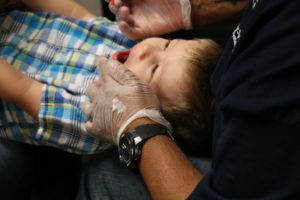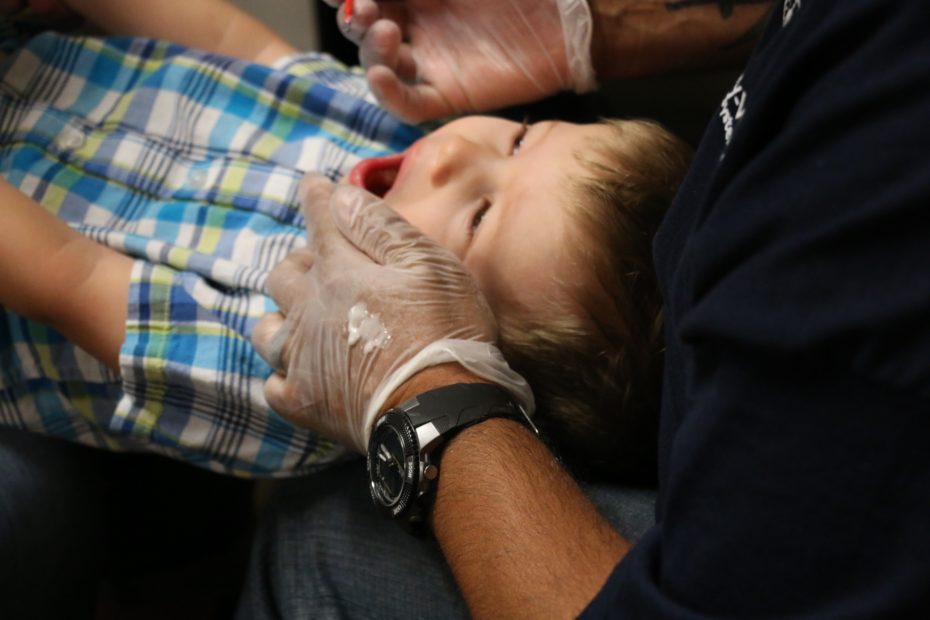
Cavity Free at Three Certified Master Trainers
From the Fall 2017 Journal of the Colorado Dental Association
Effectiveness on Early Childhood Caries of an Oral Health Promotional Program for Medical Providers, by Patricia Braun, M.D., M.P.H., et al., was published in the American Journal of Public Health in June 2017.
An Nguyen, D.D.S., M.P.H., vice-president of dental services at Clinica Family Health and CDA member, works with pediatricians and other primary care providers to refer infants and toddlers to her dental practice, educate parents about oral health and start early preventive services.
“Many parents are unaware that their child should have a dental visit when the first tooth erupts,” she says. “All children should receive these simple services in medical and dental settings. Working with medical providers to ensure children receive the critical dose of four fluoride varnishes by age 3 is easy and effective. Most kids have six or more medical visits before their second birthday, making primary care providers ideal partners in the battle against early childhood caries.”
The Colorado Department of Public Health and Environment Cavity Free at Three program is leading the way to improve access to oral health services for young children and pregnant women. The program offers free training and technical support for medical and dental providers and their staff members on how to deliver preventive oral health services to infants and toddlers. Cavity Free at Three Certified Master Trainers deliver the Cavity Free at Three curriculum and provide hands-on training to fellow medical and dental providers. The program’s current 31 Master Trainers are experts in delivering these services and maintain annual Cavity Free at Three certifications.
Katya Mauritson, D.M.D., state dental director at the health department, says Cavity Free at Three is one way the Oral Health Unit works with medical and dental providers to prevent early childhood caries, which is the number one chronic disease of childhood. Children from low-income families have double the caries of their higher-income peers and are less likely to receive dental care. Data shows that less than 7% of high-risk children with Medicaid coverage had dental visits by age 1, but most dentists start seeing children around age 3.

A pediatric patient receives a fluoride varnish treatment using the knee-to-knee technique.
Dr. Mauritson admits that these new techniques were not part of her dental training, but says they are simple and less complex than taking a radiograph or giving an immunization.
“The care standard has changed in recent years and, as dental providers, we need to keep up,” says Dr. Mauritson. “I challenge all Colorado dentists to include dental exams and fluoride varnish application for infants and toddlers, and to work with their medical provider friends.”
In Colorado, when high risk children receive oral health services at their well child visit, they are roughly 12% more likely to have a dental visit within six months. Dr. Mauritson recommends dentists follow these steps to prevent early childhood caries:
- Invite infants and toddlers into your practice.
- Include knee-to-knee exams, fluoride varnish application and caries risk assessment as part of your patient visit for infants and toddlers. Support staff can be trained to help.
- Partner with pediatric dentists to refer restorative cases as needed.
- Educate pediatricians and medical providers about oral health for infants and toddlers. Build a referral relationship with them.
- Join Cavity Free at Three, Colorado’s state health initiative.
- Visit CavityFreeAtThree.org to learn more.
- Request a Cavity Free at Three training through the website contact page.
- Request technical assistance help for implementing services through the website
- Read the research.


